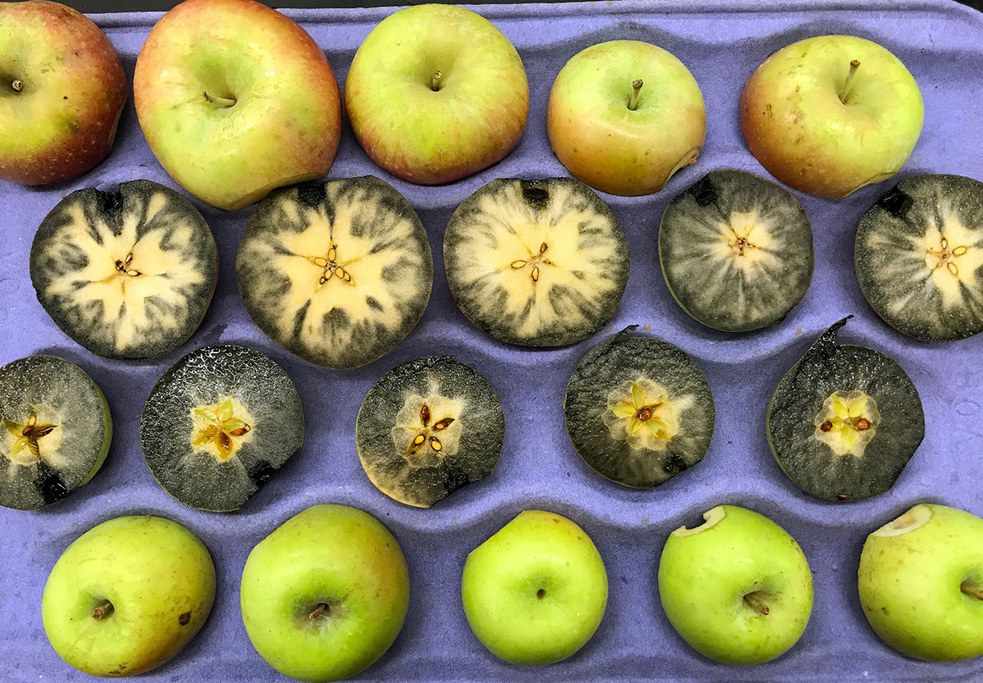Apple harvest in 2017 has been well ahead of “normal.” To update you on late season apples, this week we sampled Nagafu Fuji and GoldRush.
To begin looking at late-season pome fruit we evaluated four samples from Mike Newell at the University of Maryland's farm in Queenstown. This orchard is a relatively warm site located on the Eastern Shore, better suited to peaches and pears than apples.Nagafu Fuji and GoldRush. We tested two 'newer' late-season apple cultivars for fruit maturity and quality. Like many of the apple samples we have tested this year, fruit size was relatively small. And, like many other samples we've tested,
Nagafu Fuji and GoldRush. We tested two 'newer' late-season apple cultivars for fruit maturity and quality. Like many of the apple samples we have tested this year, fruit size was relatively small. And, like many other samples we've tested, most fruit had a number of poorly-developed seeds. Seed count was lower in the Fuji fruit, and some of the smallest Fuji apples were seedless.
Nagafu Fuji
Nagafu Fuji is difficult to color and slow to ripen, as evident in the table. While these fruit had almost 15 Brix, and were sweet, they lacked the desired Fuji flavor that develops during October. While they have not developed good red color yet, the loss of starch in the fruit flesh has begun. Fuji produces less ethylene during maturation, allowing the fruit to hang and tree ripen during much of October.
GoldRush
GoldRush fruit are still immature. While their ground color has begun turning, they are still quite firm with starchy flesh and lower soluble solids than the Fujis.

Starch staining pattern and red color development of Nagafu Fuji and GoldRush harvested from tall-spindle plantings on Maryland's Eastern Shore during the last week of September 2017. Photo: Kathy Hunt, University of Maryland
| Cultivar | Diameter (inches) | Red Color (%) | Ground Color | Firmness (pounds) | Soluble Solids (°Brix) | Starch Pattern (1-8 scale) |
|---|---|---|---|---|---|---|
| Nagafu Fuji | 3.2 | 37.5 | Yellowish Green | 17 | 14.7 | 4.4 |
| GoldRush | 2.8 | 0 | Whitish Green | 20.3 | 12.8 | 2.7 |
| Olympic pear | 3.9 | Orange | Yellowish Green | 17.2 | 14.2 | … |
| Ya Li pear | 3.1 | 0 | Greenish Yellow | 10.6 | 11.7 | … |
Asian pear
The Olympic pears were quite large with good color. The fruit were tree-ripe, firm and sweet. As you can see from the Table, their soluble solids content was similar to the Nagafu Fuji in the same planting. The Ya Li pears had softened and were juicy, but still retained some acidity. Starch staining was not measured as this is not a useful indicator of maturity in pear fruit.
For the past two years, we have published alerts about internal browning in late-season Asian pears. While we sent out that information earlier this month, we want to again remind growers of this concern. Glassy tissue in the flesh called water core, typically on the sunny side of the fruit appears to precede the internal browning (see photo).
While some browning was evident in Olympic fruit in early September, it does not seem to have gotten worse since then. We did not see any water core or browning in the Chinese cultivar Ya Li. Early-mature harvest, short-term storage, and consumer education are suggested as ways to minimize losses from internal breakdown in late-season Asian pears.

Flesh water core and orange color development of Olympic Asian pear harvested from free-standing trees on Maryland's Eastern Shore during the last week of September 2017. Photo - Kathy Hunt, University of Maryland


